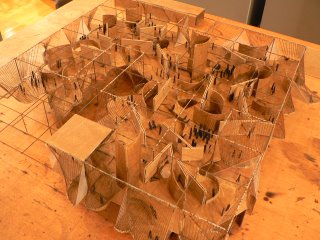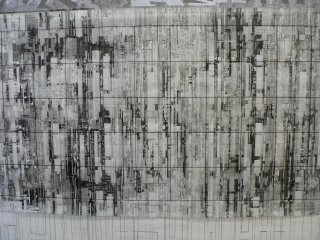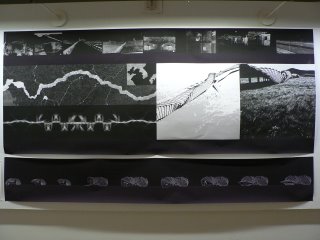Friday, July 28, 2006
Sunday, July 16, 2006
Koolhaas blows a bubble


"...His pavilion is bigger, bolder and more expensive than any of its predecessors....Its roof is a giant, helium-filled, translucent canopy, which will rise and fall depending on weather conditions. When it is cold and windy, it will lie low; but on fine days, the cables holding it down will be loosened, and its bulbous form will rise like a balloon, higher than the gallery itself...it is essentially a joyous extravagance that stretches the definition of built form a little further."
Check out a time-lapse photo of the inflation thereof!
Read more here. More pictures here .
Saturday, July 15, 2006
AA projects review + Cooper Union show + NUS arch show
This might save you a few bucks from buying the AA Projects Review soft-cover:
http://www.aaschool.ac.uk/aadvd/
Nifty web design, images a tad too small to really appreciate the work - comes off as a fancy pictureshow, and looks just about the same thing to any Projects Review from the past. (Dare I say I like the past Projects Reviews much better.)
Some images of work from Cooper Union's arch school below - hadn't seen much of their stuff since one of the early Education of an Architect books - so dropped by their end-of-year show a few weeks ago:



Some nice work, if not for the fact that everyone's models were in monotone wood, looked like every single project was done by the same person! (I love wood models though.)
Putting things in perspective (kinda), here're some images of work from the NUS arch show:




Will we ever get something that bridges between high concept and buildability, yet breaks new ground and is socially-conscious?
building blocks!
 pyramide du louvre
pyramide du louvre apple store, nyc
apple store, nyc serpentine pavilion, london
serpentine pavilion, londonReport: Let’s Tap – Architect in A Bottle
 Report: Let’s Tap – Architect in A Bottle Reported by: Soh Lin Li
Report: Let’s Tap – Architect in A Bottle Reported by: Soh Lin Li
Can architects mould a nation?
This question never occurred in my mind till it was brought up during the Up Close & Personal pre-session of the Forum: Architect in A Bottle held on the afternoon of 10th June in the Imagination Room, just hours before the actual Forum, held in at the Level 5 Courtyard.
The forum was organized by the ReallyArchitecture [re:act], comprising architectural students, professionals and individuals interested in architecture. The aim of the forum was to encourage exchange and greater discourse between the architectural community and folks from all walks of life to create a greater awareness of the role of architecture in the everyday. It was to be a heated forum in more ways than one, amidst the beautiful backdrop of the Courtyard, nicely decorated with white roses blending with the lush foliage. Made complete with beautiful mood music and warm lighting, the courtyard was packed with 167 attendees, waiting in turn to ask the panel about the influence of architecture in their lives.
The panel was made up of Dr Edward Ng, Dr Johannes Widodo and Mr Chu Lik Ren. Dr Edward Ng is an Architecture Professor at the Chinese University of Hong Kong, and an environmental consultant offering expert services to organizations and governments. His design works have been exhibited in the UK, Germany, Hong Kong and Singapore. Recently his “A Bridge Too Far” project received a “highly commended” recognition from AR, and it also won the 2006 HKIA Project Outside HK Award. Dr Johannes Widodo is an Architecture lecturer with a joint appointment as Research Leader in Asian Cities Cluster to Asia Research Institute (ARI) at the National University of Singapore. His area of specialization includes architecture, urban history and morphology of Southeast Asian cities, Asian modernity, and heritage conservation. Mr Chu Lik Ren is an Architecture lecturer at the Singapore Polytechnic. In 2004, he was one of the 20 young architects featured in URA’s “20 Under 45” exhibition.
Mr Colin Seah, who is the principal architect of the Ministry of Design, Singapore, moderated the panel discussion and Ms Gee Miaw Miin, Manager of Lee Kong Chian Reference Library, opened the session. The forum covered issues such as the re-definition of the architect’s roles, the influence of commercialization on architectural designs, HDB as the biggest community architect in Singapore, and community projects. Issues related to the Exhibition: Let’s Tap, such as the definition of space we want to live in, and reviving the memories and histories of architecture being abandoned by its inhabitants were discussed at the forum too.
The exhibitors of the Exhibition: Let’s Tap, which ran from the 3rd to 17th June at the level 8 Promenade, were also invited to the Pre-Session of the Forum, held in a Up Close and Personal round-table discussion format with the panelists. The objective of this round-table discussion was to provide a platform for interested parties to interact with the speakers on a more intimate level. Members of the Singapore Institute of Architects were invited for this intimate interaction and special guests included Pioneer Architect Mr Tay Kheng Soon, who is the Adjunct Professor of Architecture at the National University of Singapore. Mr Gene Tan, Deputy Director of INVENT, facilitated the session. The session kicked off with a discussion on the architecture of the National Library Building, and views were bandied around amongst the participants. One of the points raised was that the blueprint of the building should be documented and archived in NLB’s collections, including the architectural drawings of the other libraries.
The evolution of library buildings and usages were discussed and many felt that libraries these days have become more user-centric than books-centric. Some participants also felt that the design of the National Library has to address issues of being a research centre and a public space, albeit with Singaporean attributes. Finally the question was thrown to the floor: Do architects think that they can change the world or shape a nation? Just like the great poets in past epochs who generated emotional content crucial to the formation of a nation, the shared sentiment was that the architect does have a role in the making of a place, a nation.
